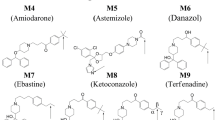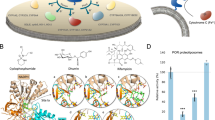Abstract
Human microsomal cytochrome P450 2A6 (CYP2A6) contributes extensively to nicotine detoxication but also activates tobacco-specific procarcinogens to mutagenic products. The CYP2A6 structure shows a compact, hydrophobic active site with one hydrogen bond donor, Asn297, that orients coumarin for regioselective oxidation. The inhibitor methoxsalen effectively fills the active site cavity without substantially perturbing the structure. The structure should aid the design of inhibitors to reduce smoking and tobacco-related cancers.
This is a preview of subscription content, access via your institution
Access options
Subscribe to this journal
Receive 12 print issues and online access
$189.00 per year
only $15.75 per issue
Buy this article
- Purchase on Springer Link
- Instant access to full article PDF
Prices may be subject to local taxes which are calculated during checkout

Similar content being viewed by others
Change history
14 August 2005
Sentence changed
Notes
Note: In the version of this article initially published online, a sentence in the fifth paragraph of the article was incorrectly transcribed. The sentence originally read, “The furan oxygen is positioned closer to the nearest carbon than to the heme iron, and the inhibitor is not positioned well for aromatic hydroxylation or epoxidation.” The error has been corrected for the HTML and the print versions of the article.
References
Malaiyandi, V., Sellers, E.M. & Tyndale, R.F. Clin. Pharmacol. Ther. 77, 145–158 (2005).
Sellers, E.M., Kaplan, H.L. & Tyndale, R.F. Clin. Pharmacol. Ther. 68, 35–43 (2000).
Sellers, E.M., Ramamoorthy, Y., Zeman, M.V., Djordjevic, M.V. & Tyndale, R.F. Nicotine Tob. Res. 5, 891–899 (2003).
Patten, C.J. et al. Carcinogenesis 18, 1623–1630 (1997).
Fujita, K. & Kamataki, T. Environ. Mol. Mutagen. 38, 339–346 (2001).
Guengerich, F.P. in Cytochrome P450: Structure, Mechanism, and Biochemistry (ed. Ortiz de Montellano, P.R.) 377–530 (Kluwer Academic/Plenum Publishers, New York, 2005).
Johnson, E.F. Drug Metab. Dispos. 31, 1532–1540 (2003).
Burley, S.K. & Petsko, G.A. Science 229, 23–28 (1985).
de Visser, S.P. & Shaik, S. J. Am. Chem. Soc. 125, 7413–7424 (2003).
Yun, C.H., Kim, K.H., Calcutt, M.W. & Guengerich, F.P. J. Biol. Chem. 280, 12279–12291 (2005).
Koenigs, L.L. & Trager, W.F. Biochemistry 37, 10047–10061 (1998).
Kleywegt, G.J. & Jones, T.A. Acta Crystallogr. D 50, 178–185 (1994).
Acknowledgements
This work was supported by the US National Institutes of Health grant GM031001 (to E.F.J.) and fellowship 12FT-0185 from the Tobacco-Related Disease Research Program (to J.K.Y.). Facilities for computer-assisted sequence analysis, DNA sequencing and the synthesis of oligonucleotides were supported in part by the General Clinical Research Center grant M01 RR00833 and by the Sam and Rose Stein Charitable Trust. Portions of this research were carried out at the Stanford Synchrotron Radiation Laboratory (SSRL), a national user facility operated by Stanford University on behalf of the US Department of Energy, Office of Basic Energy Sciences. The SSRL Structural Molecular Biology Program is supported by the Department of Energy, Office of Biological and Environmental Research and by the US National Institutes of Health, National Center for Research Resources, Biomedical Technology Program and National Institute of General Medical Sciences. The authors thank F. Gonzalez (National Cancer Institute) for kindly providing the CYP2A6 cDNA.
Author information
Authors and Affiliations
Corresponding authors
Ethics declarations
Competing interests
The authors declare no competing financial interests.
Supplementary information
Supplementary Fig. 1
The overall fold of CYP2A6 and comparison with CYP2C8. (PDF 170 kb)
Supplementary Fig. 2
Residue interactions that contribute to a compact polypeptide fold. (PDF 123 kb)
Supplementary Fig. 3
Wall-eyed stereo view of the potential hydrogen bonding of Asn297. (PDF 41 kb)
Supplementary Table 1
Data collection and refinement statistics. (PDF 28 kb)
Rights and permissions
About this article
Cite this article
Yano, J., Hsu, MH., Griffin, K. et al. Structures of human microsomal cytochrome P450 2A6 complexed with coumarin and methoxsalen. Nat Struct Mol Biol 12, 822–823 (2005). https://doi.org/10.1038/nsmb971
Received:
Accepted:
Published:
Issue Date:
DOI: https://doi.org/10.1038/nsmb971
This article is cited by
-
Involvement of cytochrome P450 enzymes in inflammation and cancer: a review
Cancer Chemotherapy and Pharmacology (2021)
-
Molecular dynamics simulations of the interaction of wild type and mutant human CYP2J2 with polyunsaturated fatty acids
BMC Research Notes (2019)
-
Functioning of drug-metabolizing microsomal cytochrome P450s: In silico probing of proteins suggests that the distal heme ‘active site’ pocket plays a relatively ‘passive role’ in some enzyme-substrate interactions
In Silico Pharmacology (2016)
-
Structure and Function of Cytochrome P450S in Insect Adaptation to Natural and Synthetic Toxins: Insights Gained from Molecular Modeling
Journal of Chemical Ecology (2013)
-
Exploration of the binding of curcumin analogues to human P450 2C9 based on docking and molecular dynamics simulation
Journal of Molecular Modeling (2012)



